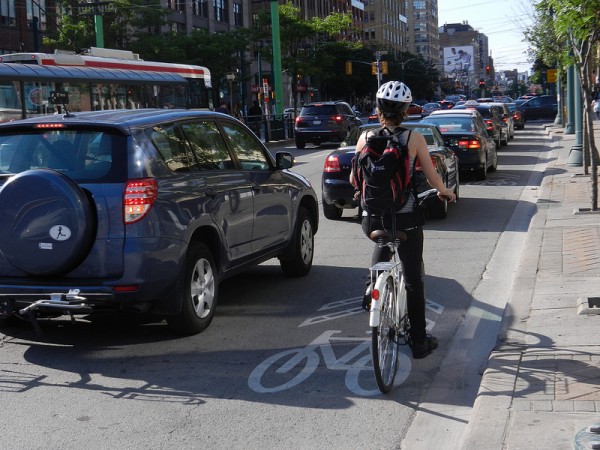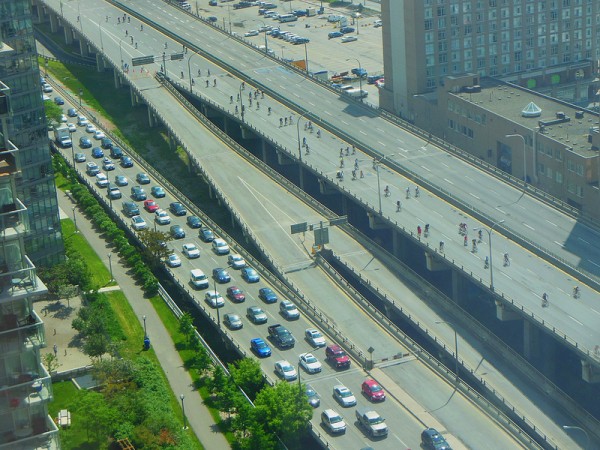This post by Daniel Arancibia is part of Spacing‘s partnership with the Toronto Cycling Think and Do Tank at the University of Toronto. Find out more about the think tank, and the series, here.
Years ago, stuck in traffic on Spadina Ave, I looked around at what appeared to be an infinite number of cars in all directions and thought to myself: “I hate being stuck in here, but how could we possibly move this many people in any other way?” I was letting my eyes do all the thinking, and sometimes our eyes deceive us.
The definition of gridlock on our streets may as well be “running out of space”. Space is often the limiting factor in the equation of modern urban mobility. 20th century planners, in response to space constraints, sought to build sprawling cities with ever larger streets (and ever increasing costs) to accommodate millions and millions of automobiles. The general idea was that space for cars would be so plentiful and densities so low that traffic would never grind to a halt as a result of congestion.
In Toronto, where most arterial streets were widened to accommodate more automobiles during the post-war period, we are running out of space again. This time around, we cannot expand the roads without destroying the very destinations roads are supposed to take us to. The good news is this is only a major problem until you consider the whole point of transportation infrastructure is to move people (and goods), and not to move cars; people take up a lot less space than cars.
While I was stuck on Spadina I wasn’t counting the cars, much less the pedestrians, cyclists, and transit users. My judgement then was a result of unconsciously equating material mass to volumes of people. It never crossed my mind that I wasn’t helping the traffic by taking 30m2 all for myself and a passenger!
Now I know that a single rush hour streetcar on Spadina Avenue moves more people than all the surrounding cars on the same block combined. I have also learned that if more of us used bicycles when making neighbourhood trips (distances less than 5km), there would be more space and less congestion for everybody (as well as cleaner air, fewer accidents, etc). Trips wouldn’t necessarily take longer: bicycles can, and often do, outperform cars and transit in tight urban settings.

To better visualise the relative spatial efficiency of automobile and bicycle traffic, I set out to capture a photograph of the Becel Heart and Stroke Ride for the Heart as riders took over the Gardiner Expressway – an elevated highway in downtown Toronto. I managed to obtain a picture where you can see approximately the same number of people on each deck of the structure – some in cars, some in bikes. In the elevated portion of the highway I counted 72 people in total (67 in bicycles and 5 pedestrians). In the lower portion (Lakeshore Blvd) I counted 60 cars carrying approximately 72 people. I used binoculars and peaked into the first 20 cars to calculate a ratio of people per vehicle of 1.2 (which is slightly more generous than the number Metrolinx uses, of 1.15 people per car).
The picture speaks for itself. Not only could you fit at least 4 times as many cyclists in the upper deck without affecting traffic flow, people on bicycles were moving faster than those in the cars below!
The interesting thing is that you could probably fit all the cyclists pictured on the upper deck into the space of a single traffic lane without much difficulty. Allocating paths and lanes for cyclists throughout the city would in effect increase the capacity of roads rather than decrease it. This would be especially true if these lanes encourage people who are currently ‘interested but concerned’ to use their bicycles for transportation.
In a city that has become globally notorious for its congestion, we need to consider allocating more road space to those who use it most efficiently.
Daniel Arancibia is a research assistant with the Toronto Cycling Think & Do Tank


6 comments
I like how you drop this bomb “This would be especially true if these lanes encourage people who are currently ‘interested but concerned’ to use their bicycles for transportation.” at the end. More accurately, this would be ONLY true if these lanes encourage more people to cycle.
In trying to think outside the box you have basically completely ignored every factor except the physical volume of each vehicle, and your comparisons are problematic. You noticed that bikers on the highway were going faster than cars? Gee I wonder if that has anything to do with the congestion in the lower level being doubled because of the bikers on the upper level.
According to the city of Toronto, something like 20% of the land area is public roads and parking, this excludes driveways, private roads and private parking. That represents a pretty large hunk of the city that is paved over. At least half of that is extra lanes and parking to handle automobile traffic.
Personally I think the city in 2100 will look a lot more like it did in 1900, then what it looked like in 2000…. Lots of little neighborhoods, except we will connect them by subways, rather the arterials.
Mike,
If you had the same amount of people in cars as the number of cyclists in the upper deck, they too would have been moving at a turtle’s pace, and slower than bicycles. You should be able to deduce that from the picture.
As things stand in Toronto, there are streets where 40% of the traffic at morning rush hour consists of bicycles, and where even higher percentages consist of transit users. Both cyclists and transit users are currently being held back by cars, and in turn hold other cars behind them. There are many streets, such as Portland, where cyclists are frequently forced to take a full lane because they have nowhere to go safely and must take much more space than they need. Where bicycle infrastructure has existed for a long time, such as along College street, some counts indicate there may be close to 1,000 cyclists per hour passing through certain intersections at rush! Imagine putting this amount of people in the crowded streetcars or cars and the effect it would have on everyone else’s mobility.
There are also many people who already cycle for transportation but drive to certain places because routes are unsafe or inappropriate. In Downtown Toronto, where close to 10% of residents use a bicycle as their primary mode of transportation (versus 15% car usage), and where 85% of people do not drive as part of their commute, it would be possible to improve mobility by assigning less space to cars even if mode share stayed the same. Don’t forget congestion would also improve if transit users (rather than cyclists) switch to cycling, and some drivers switch to transit to take advantage of the extra capacity.
Daniel,
Your first statement is either bold-facedly dishonest or ignorant, or have you never seen a car travelling at 120km/h on the Gardiner? I don’t think there’s a point in having a discussion with someone completely divorced from reality.
Mike, you’re such a pleasant debater!
Mike,
I suggest you read what you are responding to so as to avoid incoherent comebacks.
P.S. Are you Dave from Scarborough?